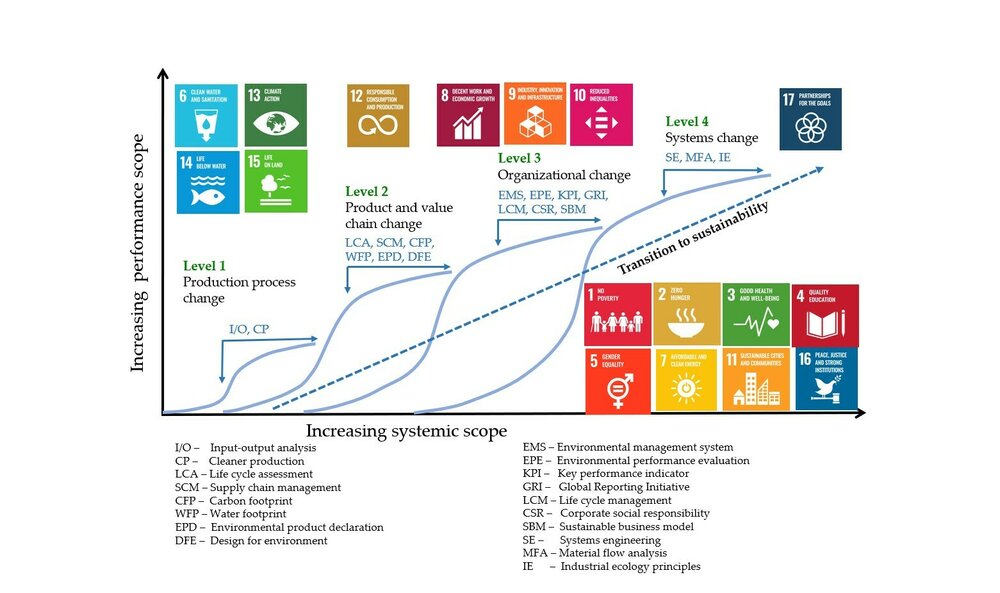Mapping the SDGs on the CapSEM-model
 Source: Fet and Knudson, 2022
Source: Fet and Knudson, 2022
The SDGs have become a prominent guiding framework to improve companies’ sustainability strategies through stepwise systemic changes. The SDGs can be placed along the stepwise CapSEM model. Recognizing the systemic foundation of the framework, it must be noted that even though the goals are placed to illustrate areas of improvement at a specific level, they can also be applied on each of the other levels.
Achievements on Level 1, such as by reduction of inputs to and outputs from a process, will contribute to a reduced impact on nature, air, water and soil, hereby represented by SDGs 6 (Clean water and sanitation), 13 (Climate action), 14 (Life below water) and 15 (Life on land).
On Level 2, SDG 12 puts attention on the entire value chain of products through its targets for achieving responsible consumption and production. The potential improvements can be analyzed and implemented by means of the life cycle and value chain related tools, with an ultimate goal of transforming linear production and consumption models into circular ones. SDG 7 (Affordable and clean energy) can also be placed on Level 3 since the reduction in negative environmental impacts of a product or service is often dependent on energy supply systems. Additionally, transport along the value chain is also depends on energy price and availability.
The SDGs that are most related to Level 3 – the business organizational level, are goals 8 (Decent work and economic growth), 9 (Industry, innovation and infrastructure) and 10 (Reduced inequalities). SDGs 8 and 9 represent the economic aspects of sustainability with their focus on economic growth, industry, innovation and infrastructure. The transition towards more sustainable solutions and business practices can be achieved by the progression toward sustainable business models through the appropriate application of other Level 1–3 tools.
At the highest level, Level 4, the remaining SDGs are placed because they are both the drivers for and foundation of systemic change. Here, we find SDGs 1 (No poverty), 2 (Zero hunger), 3 (Good health and well-being), 4 (Quality education) and 5 (Gender equality) as they are concentrated on the basic needs and livelihoods of society. Goals 5 and 6 represent the social aspects to inequalities among employees in an organization. Without their fulfillment, systemic change towards sustainability will neither happen nor last over time. Arguably, goals 13, 14 and 15 could also be placed on Level 4 as they represent the planetary boundaries and Earth life support system imperative to human existence. SDG 11 (Sustainable cities and communities) represents the living conditions for people in both rural and urban communities. SDG 11 powerfully exemplifies the stepwise model, as SDGs 5, 6, 7, 8 and 9, for example, are all essential for sustainable city and rural infrastructure. In addition, SDGs 16 (Peace, justice and strong institutions) and 17 (Partnerships for the goals) are placed on the highest-level illustrating that without peace and partnership, it will be difficult to foster the justice and strong institutions for a sustainable global society. Goal 17 also specifically calls for collaboration through, among others, its targets on multi-stakeholder partnerships for sharing knowledge, expertise, technology and financial resources (targets 17.16 and 17.17).
Final Report from the initial CapSEM-project
The initial CapSEM-project, CapSEM – Capacity building in Sustainability and Environmental Management, was co-funded by the Erasmus+ Program of the European Union and has been conducted from October 2016 through October 2019. Read the report CAPACITY BUILDING in SUSTAINABILITY and ENVIRONMENTAL MANAGEMENT (pdf).
